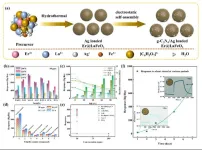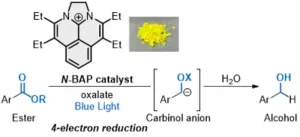Protein-rich diets may influence gut microbiome and body composition
2024-06-15
(Press-News.org) Atlanta, GA – New research has shed light on the effects of protein-rich diets on the gut microbiome and overall health. Despite the increasing protein intake in Western diets, especially among athletes and individuals with obesity, the fate of undigested protein and its impact on human health remains largely unknown. A new study, presented at ASM Microbe, explores how excess undigested protein in the colon can be fermented to produce beneficial metabolites, such as short-chain fatty acids (SCFAs), or lead to the production of harmful metabolites like ammonia and sulfides, which are linked to gastrointestinal disorders and other health issues.
The research team conducted a series of experiments on mice, discovering that a switch to a protein-rich diet resulted in significant weight loss, reduced body fat and induced immediate changes to the gut microbiome. The study also compared different protein diets to examine the effects of individual amino acids on the gut microbiome's composition and activity. Notably, the mice consuming aromatic amino-acid-rich proteins experienced the greatest weight and fat mass loss compared to those on standard protein and branched-chain amino-acid-rich protein diets.
"These findings provide a crucial foundation for understanding how protein diets influence the gut microbiome and open doors for further investigations into the role of diet in promoting a healthy gut and overall health," said Samson Adejumo, Doctoral Candidate in Biology, University of Illinois Chicago.
To delve deeper into the effects of amino acids in protein-rich diets on gut bacteria, the team conducted a 4-week experiment with 16 mice. Initially, the mice were given a standard chow diet for 2 weeks, followed by isonitrogenous protein-rich diets enriched with either branched-chain or aromatic amino acids for the subsequent 2 weeks. Daily fecal samples and weekly body composition measurements were collected to monitor changes in fat and fat-free mass. DNA was extracted from the feces, and sequencing was performed to analyze microbial composition and dynamics over the study period.
The comparison of microbial composition across the 4 protein groups revealed significantly different microbial taxa abundance and composition following protein enrichment. Using machine learning techniques, the researchers predicted protein diets based on gut microbial taxa with 97% accuracy, supporting the relationship between diet and microbiome changes.
Overall, the gut bacteria genera responded differently to dietary changes, from regular carbohydrate diets to protein diets, and more importantly, to different amino acid groups. The most substantial changes occurred in the group fed branched-chain amino acids. Although it is too early to conclusively state that protein diets caused all observed changes in body composition and gut bacteria, the consistent pattern of changes strongly indicates a connection between protein diets and gut microbiome alterations.
The research was led by Adejumo at Marcell lab, University of Illinois Chicago, with support from the UIC Hampton-Marcell lab startup fund, and was presented at ASM Microbe 2024 in Atlanta, Georgia on June 15, 2024.
###
ASM Microbe is the annual meeting of the American Society for Microbiology, held June 13-17, 2024, in Atlanta, Georgia.
The American Society for Microbiology is one of the largest professional societies dedicated to the life sciences and is composed of 36,000 scientists and health practitioners. ASM's mission is to promote and advance the microbial sciences.
ASM advances the microbial sciences through conferences, publications, certifications, educational opportunities and advocacy efforts. It enhances laboratory capacity around the globe through training and resources. It provides a network for scientists in academia, industry and clinical settings. Additionally, ASM promotes a deeper understanding of the microbial sciences to diverse audiences.
END
ELSE PRESS RELEASES FROM THIS DATE:
2024-06-15
Highlights:
Mouse studies suggest a link between the gut microbiome and neurodegenerative diseases, but the pathways remain unclear.
New study reports distinct bacterial and metabolite profile in patients with Alzheimer’s disease and other neurodegenerative diseases.
The study flagged the metabolite DHPS as a possible missing link in our understanding of how gut microbes influence NDDs through sulfur metabolism pathways.
Atlanta, Ga.—Neurodegenerative diseases (NDDs), which have no known cures and elusive causes, result in irreversible damage to the brain and nervous system. Research into these diseases typically focuses on the brain, but mouse ...
2024-06-15
TLS are accumulations of lymphoid cells that share similar cellular compartments, organization, and function as secondary lymphoid organs. Importantly, the presence of these structures in inflamed salivary glands associated with active disease, increased autoantibody production, and malignancy risk.
“To treat patients effectively, comprehensive understanding of the salivary gland microenvironment is needed”, said Saba Nayar, “but current profiling efforts often struggle to capture high-plex 'omics data while preserving the spatial architecture of the tissue.”
To ...
2024-06-15
The 16-week Plants for Joints trial investigated the effects of a multidisciplinary lifestyle intervention in people with RA, as compared to usual care. The intervention was based on a whole-food, plant-based diet – alongside physical activity and stress management. Previous reports showed this intervention significantly reduced the 28-joint disease activity score (DAS28) compared to usual care alone.2,3 To expand on this, the researchers wanted to determine the long-term effectiveness of the intervention, specifically with ...
2024-06-15
The volatile of isoamyl alcohol released from the stored wheat increased with the storage extending, making it one of the potential biomarkers for the early-stage of wheat mildew. Currently, there is a scarcity of chemiresistors for isoamyl alcohol detection, which suffer from low sensitivity. The team of material scientists led by Professor Chao Zhang reported that LaFeO3-based sensing materials demonstrated remarkable sensitivity for isoamyl alcohol (DOI: 10.1039/D3TA05718F, 10.1007/s11666-024-01740-4). However, it’s essential to note that there is still potential for lowering the optimal operating temperature and enhancing moisture ...
2024-06-15
The sweet smell of strawberries and other fruits is thanks to a chemical compound called ester, which is also found in many fats and polyesters. The ubiquitous compound can be broken down to produce desirable alcohols and other chemicals for use across industries including pharmaceuticals and cosmetics, but the process can be costly, both financially and in terms of the environment.
Now, a team of researchers with the National Institutes of Natural Sciences (NINS) in Japan has developed a novel approach using light as an energy ...
2024-06-15
As temperatures rise, so do chances for migraine attacks, according to a new study from a team of researchers at the University of Cincinnati College of Medicine, Icahn School of Medicine at Mount Sinai, Errex Inc. and Teva Pharmaceuticals USA. Inc.
“Weather change is one of the most common trigger factors for migraine,” says Vincent Martin, MD, director of the Headache and Facial Pain Center at UC's Gardner Neuroscience Institute and UC Health physician. He is the study’s lead author and president of the National Headache Foundation.
These findings from the study, which looked at use of Fremanezumab and whether it could prevent headaches ...
2024-06-15
Cyanobacteria are one of the oldest and most important life forms in the world – for example as they took an essential part in producing the oxygen in our atmosphere. Some types form long filaments composed of a few to more than 1,000 individual cells. In this form, the filamentous bacteria can move around. The principles of this locomotion have now been investigated by a research team led by Stefan Karpitschka, group leader at the MPI-DS and professor at the University of Konstanz, in collaboration with the University of Bayreuth and the University of Göttingen.
"We measured the force during locomotion on individual ...
2024-06-15
Omics analysis is the process of analyzing large data sets to extract meaningful information about biological molecules—genes, DNA, RNA, proteins, metabolites or more—with the goal of illuminating typical molecular pathways and deciphering where things go awry in disease. In a study led by Bruno A. Benitez, MD, a human geneticist and director of the Neurobiorepository in the department of Neurology at Beth Israel Deaconess Medical Center (BIDMC), investigators used machine learning approaches to integrate high-throughput transcriptomic, proteomic, metabolomic, and lipidomic profiles to provide novel ...
2024-06-15
In a new paper, researchers from Carnegie Mellon University and Stevens Institute of Technology show a new way of thinking about the fair impacts of AI decisions.
They draw on a well-established tradition known as social welfare optimization, which aims to make decisions fairer by focusing on the overall benefits and harms to individuals. This method can be used to evaluate the industry standard assessment tools for AI fairness, which look at approval rates across protected groups.
"In assessing fairness, the AI community tries to ensure equitable treatment for groups that differ in economic level, ...
2024-06-14
WASHINGTON – U.S. Naval Research Laboratory scientists and engineers received the prestigious Department of Navy Dr. Delores M. Etter Top Scientists and Engineers of the Year Award, June 12, during an awards ceremony hosted at the Pentagon.
“The Top Scientists and Engineers of the Year award program recognizes and acknowledges the excellence of our highest performing scientists and engineers in support of the Department of the Navy," said Frederick J. Stefany, Assistant Secretary of the Navy for Research, ...
LAST 30 PRESS RELEASES:
[Press-News.org] Protein-rich diets may influence gut microbiome and body composition




